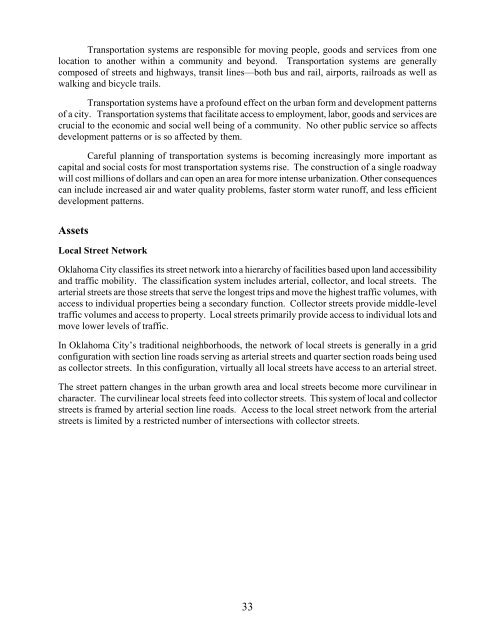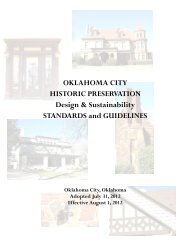OKC Plan, 2000-2020 - City of Oklahoma City
OKC Plan, 2000-2020 - City of Oklahoma City
OKC Plan, 2000-2020 - City of Oklahoma City
Create successful ePaper yourself
Turn your PDF publications into a flip-book with our unique Google optimized e-Paper software.
Transportation systems are responsible for moving people, goods and services from one<br />
location to another within a community and beyond. Transportation systems are generally<br />
composed <strong>of</strong> streets and highways, transit lines—both bus and rail, airports, railroads as well as<br />
walking and bicycle trails.<br />
Transportation systems have a pr<strong>of</strong>ound effect on the urban form and development patterns<br />
<strong>of</strong> a city. Transportation systems that facilitate access to employment, labor, goods and services are<br />
crucial to the economic and social well being <strong>of</strong> a community. No other public service so affects<br />
development patterns or is so affected by them.<br />
Careful planning <strong>of</strong> transportation systems is becoming increasingly more important as<br />
capital and social costs for most transportation systems rise. The construction <strong>of</strong> a single roadway<br />
will cost millions <strong>of</strong> dollars and can open an area for more intense urbanization. Other consequences<br />
can include increased air and water quality problems, faster storm water run<strong>of</strong>f, and less efficient<br />
development patterns.<br />
Assets<br />
Local Street Network<br />
<strong>Oklahoma</strong> <strong>City</strong> classifies its street network into a hierarchy <strong>of</strong> facilities based upon land accessibility<br />
and traffic mobility. The classification system includes arterial, collector, and local streets. The<br />
arterial streets are those streets that serve the longest trips and move the highest traffic volumes, with<br />
access to individual properties being a secondary function. Collector streets provide middle-level<br />
traffic volumes and access to property. Local streets primarily provide access to individual lots and<br />
move lower levels <strong>of</strong> traffic.<br />
In <strong>Oklahoma</strong> <strong>City</strong>’s traditional neighborhoods, the network <strong>of</strong> local streets is generally in a grid<br />
configuration with section line roads serving as arterial streets and quarter section roads being used<br />
as collector streets. In this configuration, virtually all local streets have access to an arterial street.<br />
The street pattern changes in the urban growth area and local streets become more curvilinear in<br />
character. The curvilinear local streets feed into collector streets. This system <strong>of</strong> local and collector<br />
streets is framed by arterial section line roads. Access to the local street network from the arterial<br />
streets is limited by a restricted number <strong>of</strong> intersections with collector streets.<br />
33

















